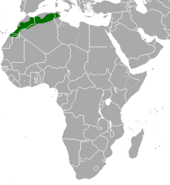Cuvier Gazelle
| Cuvier Gazelle | ||||||||||||
|---|---|---|---|---|---|---|---|---|---|---|---|---|

Cuvier Gazelle |
||||||||||||
| Systematics | ||||||||||||
|
||||||||||||
| Scientific name | ||||||||||||
| Gazella cuvieri | ||||||||||||
| ( Ogilby , 1841) |
The Cuvier gazelle ( Gazella cuvieri ) is a species of mammal belonging to the genus of the gazelles . It lives in the Atlas Mountains in North Africa and is considered threatened. It is one of the few mountain-dwelling species of gazelle in Africa and occurs at altitudes of up to 2,000 meters.
features
The Cuvier gazelle is one of the darkest types of gazelle. Their fur is colored gray-brown on the upper side and is separated from the light underside by a dark stripe. The horns are around 20 to 37 centimeters long and are larger in the males as in all gazelle species than in the females. The face is characterized by dark stripes that run from the eyes to the muzzle, within which white stripes run parallel. Cuvier's gazelles reach a head body length of 95 to 105 centimeters, with a tail 15 to 20 centimeters in addition. The shoulder height is around 60 to 70 centimeters and the weight 15 to 20 kilograms for females and 20 to 35 kilograms for males.
distribution and habitat
The distribution area of the Cuvier's gazelles is in North Africa and extends from Morocco to Tunisia . They inhabit various habitats within the Atlas Mountains , including forests and rocky plateaus. One of the most important protected areas for this species is the Djebel Chambi National Park , which is home to the largest population in Tunisia.
Way of life
Cuvier gazelles live in small groups, which usually consist of fewer than eight animals and are usually composed of a male, one or more females and a few young animals. They spend the day hidden at higher altitudes in order to come down into the valleys to eat at dusk or at night. Their diet is made up of grasses and herbs.
Reproduction
The majority of births fall between March and May, and sometimes there is a second peak in October. The gestation period is around 160 days, unusual among the African gazelles is the high number of twin births. Life expectancy is up to 14 years.
Danger
At the beginning of the 20th century, the Cuvier's gazelle was still widespread over large parts of North Africa, but its populations have drastically decreased due to hunting and the restriction of its habitat by converting it to pasture. Today the species only inhabits a reduced and fragmented area. Estimates from 2001 put the total population at 1500 to 2500 animals, of which around 500 to 1500 live in Morocco, around 560 in Algeria and less than 500 in Tunisia. The IUCN lists the species as endangered .
supporting documents
literature
- CA Spinage: The Natural History of Antelopes . Croom Helm, London 1986, ISBN 0-7099-4441-1
Web links
- Information, photos and distribution map on Ultimate Ungulate
- Exact stock numbers on Animal Info
- Gazella cuvieri in the endangered Red List species the IUCN 2006. Posted by: Antelope Specialist Group, 1996. Accessed on 1 1 of 2007.
Single receipts
- ↑ Spinage, p. 191
